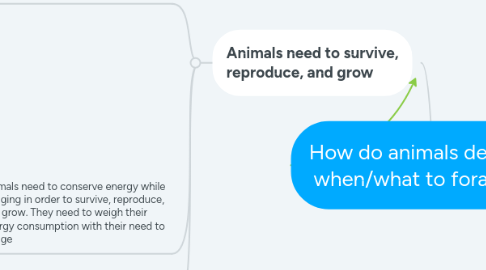
1. Animals need to survive, reproduce, and grow
1.1. Predation decreases animals ability to survive
1.1.1. In order to increase their fitness, animals have to change their foraging habits in order to decrease predation risk.
1.1.1.1. Adapt sensitivity to predator scent
1.1.1.1.1. We predict that animals will forage less when there is a predator scent present near food than if there is no scent or a novel scent.
1.1.1.2. Decrease exposure to predators by eating foods with small handling time
1.1.1.2.1. We predict that animals will take more food with a smaller handling time.
1.1.1.3. Forage at times where predators are less prevalent
1.1.1.3.1. We predict animals forage more during the hours of the night, specifically 9 pm to 12am, than they will during the day from 12pm-3pm.
1.1.1.4. Animals also decrease predation risk by straying away from food presented by foreign objects
1.1.1.4.1. We predict that animals generally eat less plated peanuts than un-plated peanuts.
1.1.1.4.2. Prediction: Animals at a more secluded place will eat less plated nuts than at Siena College.
1.1.1.4.3. Animals at a more populated site like Siena College are most likely adapted to food on plates.
1.2. Animals need to conserve energy while foraging in order to survive, reproduce, and grow. They need to weigh their energy consumption with their need to forage
1.2.1. This leads to changes in foraging behavior. For example, eating foods with shorter handling time.
1.3. Animals need to forage in order to survive, reproduce, and grow
1.3.1. Animals need to weigh costs between predation risk and their need for food by making changes to their foraging behavior.
